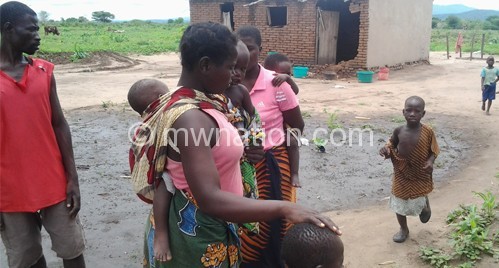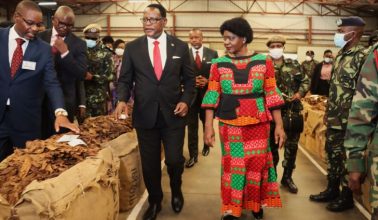Karonga’s battle of booming broods

Under the tumultuous land disputes that displaced about 140 people in Karonga, whispers of a growing populations’ scramble for limited resources. JAMES CHAVULA writes.
Malawi’s may be an agricultural economy, but it is no stranger to how rapid population growth is slowly turning land and its endowments into a source of conflicts among neighbouring communities on the continent.
The case in point is Karonga Central where the obvious losers—Mwenekasimbas of Mchenjere Village—personify over 80 percent of Malawians who rely on agriculture, according to the Integrated Household Survey of 2005.
The clan is now living in a ‘refugee camp’ dotted with overcrowded tents after being forced out of their homes by the Mwaungulus of the neighbouring Kabanga villagers in a gory fight for a riverside piece of land which erupted on December 30 2013.
In the village, every pathway is by stark reminders of the confrontation: demolished walls and gutted roofs of affected houses; kitchens, toilets and other sanitary facilities reduced to rubble; scatters of kitchenware, chairs, tables and other precious property soaking in the rain; no bleating of goats, mewing cows and other livestock. The people that used to fish and farm with smiles have been reduced to a camp of sorry faces telling tales of fear and surrender.
“Ours is no political war; it’s all about land for our children,” says Wiseman Kasimba, flipping through a pile of wet paper where he documents losses resulting from the dispute.
Growing numbers
The records show nine houses that were pulled down. Twelve grass-thatched houses were also torched down.
Like 20 locals interviewed, Kasimba recalls: “Things came to a head on December 30 2013 when we crossed into Kabanga to reclaim our piece of land the Mwaungulus have been using for decades. We couldn’t allow this anymore because our clan is growing, the children are becoming adults. The land is our inheritance, the major source of income and livelihood.”
This puts into perspective how ever-increasing population is exerting pressure on land which is not getting bigger, but bleached. In the shoreline community, the pressure is increasing as fishing is becoming less lucrative, with lowering fish stocks in Lake Malawi due to overfishing aimed at meeting the rising demand from a population on the rise.
Based on the latest census, the National Statistical Office (NSO) projects that the country, which used to nourish about 13. 5 million people in 1998, is expected to be home to 15.5 million this year and 26.09 million in 2030. In the same duration, Karonga’s figure has swelled from 279 421 to 327 084.
“Rapid population growth places enormous pressure on natural resources such as forests, water and land. Already scarce, farmland must be divided among more people resulting in smaller plots and poorer land quality,” former UNFPA population and development manager Dr Thomas Chataghalala Munthali told the press last year, estimating the cost of unsustainable use of natural resources due to the population boom at 50 tambala in every K10 required for economic growth every year.
According to the clan’s elders, the descendant of Moses Kasimba and Lukumba Mwaungulu have been struggling for the contentious land since 1977 when government commissioned Lupembe Maize Scheme to advance modern agricultural methods and food security for the rising population.
“The major problem is rapid population growth. Our children are growing and they need land for their children and family. That is what compelled our clansmen to go to the other side to reclaim our land the day we were attacked,” says Kasimba.
Struggle for space
Since June last year, group village head (GVH) Mwalamba and principal village head Mwangolera have tried Mwenekasimba’s claim and ruled in favour of the Mwaungulus.
In November, they appealed to Paramount Chief Kyungu’s council which granted them rights to the land although it lies across River Kasimba, the boundary of Mchenjere and Kabanga.
It is against a rising revolt among Mwenekabangas that 19 Mwenekasimbas— reportedly armed with two axes, three panga knives and hoes—went to share the disputed land that sunny Monday morning.
A casualty, Vyanitonda Kasimba, recalls: “On our arrival in the fields, the Mwaungulus started whistling, ululating, beating drums and mobilising each other for war. In no time, about 200 heavily armed men surrounded us, ordered us to surrender our equipment and grabbed our granny Moses Kasimba, telling him they had not come to ask why we were in their land but to deal with him once and for all.”
Vyanitonda confesses being beaten as the youthful clansmen escaped “the battle for more space”, leaving elders being pounded by the mob, which hammered a nail into his palm and left him for dead.
The survivors accuse the Mwaungulus who were pursuing the ‘fleeing invaders’ of burning, breaking and looting affected homes.
During a visit to the battlefield on January 13, Moses Kasimba was still receiving treatment at Karonga District Hospital. His house was lying in ruins, his family living on handouts and his wife only happy that “he was back from the dead at last”.
Strikingly, women at the camp had up to six children, a fertility rate that has pushed the country’s population from a mere three million in 1950 to 15.5 million today. In 2010, the UN World Populations Prospects projected that the figure may reach 50 million by 2050.
“This growth is mostly driven by high fertility, which has declined modestly from 7.2 children per woman in 1970 to 5.8 percent in 2010,” indicates the 2010 Malawi Health Demographic Survey.
In the village, we saw a girl, 15, breastfeeding a baby. She dropped out of school due to an early pregnancy which put her at the risk of death from birth complications. Although the nationwide health survey shows increased access to contraception from 13 percent in 1992 to 46 percent in 2010, the girl is likely to have more children.
Yet women at the camp testify that having more than two children worsens the livelihood in times of disasters. This is clear as the displaced community cries for food, clothes blankets, clean water and other urgent relief items.
Numerous problems
When it rains, Paulina Nyankhonde shares one of the 25 tents donated by World Vision Malawi with her husband and six children. Yet the tents measure about 1.5m in all directions.
“We were already struggling to feed, clothe and educate our children before our home was destroyed. Now, we are scrambling for space in crowded tents. We sleep on a bare floor with nothing to shield us from the cold breeze from the lake,” says Nyankhonde, likening the experience to the pain of seeing children going to school in rags because their uniforms were destroyed alongside other goods.
Records show the destruction of 21 houses has left 68 school going children homeless.
Also at stake are the lives of 34 children under five, six pregnant women and 11 breastfeeding mothers, five people with disabilities and 13 with HIV and Aids or TB.
Three breastfeeding children were spotted with trachoma or vimbokoli, a disease which thrives on unsanitary conditions common in the camp. Malaria, a major killer disease for infants and pregnant women in the country, is increasingly spreading at the crammed camp.
“It is difficult to hang the treated mosquito nets in the low-lying tents which are so small that most men are compelled to sleep in the open when it is not raining,” says Emily Nkhana as one of her four children was recuperating from malaria.
Jane Lughali likens the emergency home, overlooking the ruins of her broken house, to a refugee camp
“I was washing plates when the crowd came, destroyed the house, set our goods ablaze, stole some valuables and left us with countless problems like refugees,” laments Lughali, a mother of four.
The numerous problems for the likes of Leah Manda include an uncertain future. She says: “We are like newborns, left with nothing to fall back on when this agony is over.”
Dickson Kasimba, who was tilling his land with an ox-drawn plough in the vicinity of the camp, is convinced that the displaced will wake up to untold food insecurity when rainy season ends.
“With their subsidised fertiliser and seeds destroyed, most people do not have the funds to replant. This is a recipe for disaster,” said the man whose grass-thatched home was annihilated.
Social breakdown
Also up in flames is the bond holding the two villages together. Locals say there was a time, before a simmering land issue became a dispute, when the people of Kasimba and Mwaungulu of Karonga were one. They intermarried. They drank khangala and other local brews from one calabash. They used to share business space at Ndembwera Trading Centre.
Now, a boiling river of furry splits them into cats and mice. That metaphorical wedge is River Kasimba which pours into Lake Malawi where villagers from either side fish without fearing or distrusting each other.
Crossing the river has become a matter of life or death, say the locals on the side-effects of the wrangle, which saw Kyungu sacking Village Mwakabanga for inciting the face-off.
On the other hand, Mwakabanga faults Kyungu’s verdict for catalysing bad neighbourliness, saying: “When people come to you to settle their dispute and later resort to fighting, something could be wrong with the verdict.”
Mwakabanga says this is a lesson learnt from years of presiding over cases, including land dispute which are increasing with rapid population growth.






Learn to write short and concise articles. For Malawians, its easy kukwerana (to have sex) with little regard for the outcomes, pregnancy and children. You see this all the way from Chitipa to Nsanje. Family planning and better methods of agriculture to increase land productivity are the solutions. Unfortunately, these are not priorities for the fools that are chosen to lead the nation, rather they distribute zitenje which just encourage young girl to screw around in the bushes on the new zitenjes.
@ Nyambalo
Did I missout something?